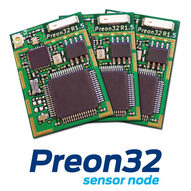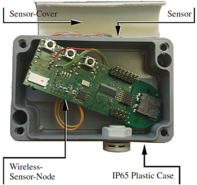Wireless sensor networks for remote monitoring of food transport
In order to provide an accurate prediction of shelf life, it is necessary to measure temperature inside food pallets or transport boxes. In total, 10 to 20 sensors were required to capture local temperature deviations inside a truck or container.
The implementation of wireless sensor networks is hindered by the high signal attenuation of food products due to their high water content. This is especially the case for frequencies above 1 GHz, as measurements and models for signal propagation have shown [![]() 3]. A reliable communication can only be provided if messages are forwarded over multiple hops between the sensors. In a world-wide scenario, sensors of different manufacturers and transport operators have to be linked together. Therefore, it is inevitable to identify and further develop adequate standardised communication protocols.
3]. A reliable communication can only be provided if messages are forwarded over multiple hops between the sensors. In a world-wide scenario, sensors of different manufacturers and transport operators have to be linked together. Therefore, it is inevitable to identify and further develop adequate standardised communication protocols.
6LoWPAN and CoAP
Common Internet protocols such as HTTP have achieved a high level of standardisation. During the project we were able to show that it is feasible to obtain a high degree of compatibility between these protocols. In order to deal with the constrained nature of sensor nodes, there are mainly two protocols used:
- The IPv6 over Low power Wireless Personal Area Networks (6LoWPAN) protocol enables wireless sensor nodes to be addressed as any other internet device.
- The Constrained Application Protocol (CoAP) is specially adapted to the requirements of Machine-to-Machine (M2M) communication. CoAP is designed for easy interfacing with HTTP, but provides a reduced message length.
A CoAP implementation for the TinyOS operating system was developed for the intelligent container project and thus provided a CoAP platform for wireless sensor nodes. In further work, it was also made possible to exchange messages with sensor nodes, which were running the alternate Contiki operating system.
Hardware platform
During our field tests we applied the standard TelosB node as well as two alternate hardware platforms for wireless sensor nodes, which were developed by our project partners:
- The Preon32 sensor node from Virtenio is based on an energy efficient ARM processor. Its high CPU power enables the programming of algorithms for complex shelf life models, directly on the sensor. Programming is simplified by the Preon32’s capability to directly execute Java code.
- A tremendous portion of the node’s battery capacity was required to power up the radio periodically in order to listen for requests from other sensors. The second new hardware approach implements a wake-up circuit by use of semi-passive RFID technology, thereby removing the need for such idle-listening. As long as no wake-up signal is received, the node requires almost no energy.
Additionally, the sensor node measured the strength of the wake-up signal along the three spatial axes. This information is planned to be used for estimating the node’s position inside the container.
Relevant publications
- Pötsch, T., Kuladinithi, K., Becker, M., Trenkamp, P., Görg, C.: “Performance Evaluation of CoAP using RPL and LPL in TinyOS”. In Proc. of Fifth IFIP International Conference on New Technologies, Mobility and Security (NTMS 2012). Istanbul, Turkey. 7.-10.5.2012. DOI:
 10.1109/NTMS.2012.6208761
10.1109/NTMS.2012.6208761 - Heidmann, N.; Hellwege, N.; Peters-Drolshagen, D.; Paul, S.; Dannies, A.; Lang, W.: A low-power wireless UHF/LF sensor network with web-based remote supervision - Implementation in the intelligent container. In: Sensors, 2013 IEEE, 2013, pp. 1-4. DOI:
 10.1109/ICSENS.2013.6688422
10.1109/ICSENS.2013.6688422 - Jedermann, R., Pötsch, T., Lloyd, C.: Communication techniques and challenges for wireless food quality monitoring. Philosophical Transactions of the Royal Society A, May/June 2014, Vol. 372(2017), 20130304. DOI:
 10.1098/rsta.2013.0304
10.1098/rsta.2013.0304
Contact
Reiner Jedermann, Reiner Jedermann, Institute for Microsensors-, actuators and -systems (IMSAS), University of Bremen, ![]() Email
Email
Communication Networks Working Group (ComNets), University of Bremen
Henri Kretschmer VIRTENIO GmbH, ![]() Email
Email











